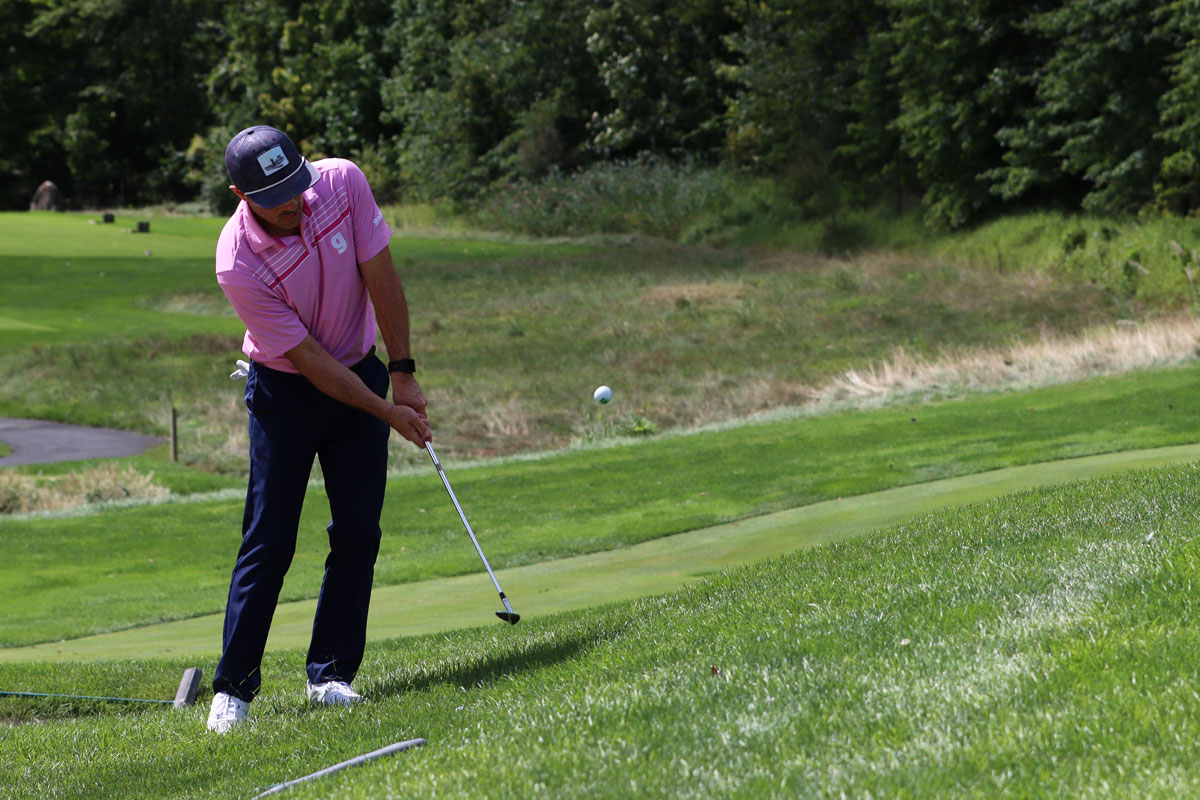Club Selection
A Simple Chipping Club Selection Strategy for Better Distance Control

When facing any shot in golf, one of the first things you need to do is select one of your 14 clubs for the job.
This article is dedicated to the art of picking the right clubs for your chip shots. Specifically, we’ll be focused on getting your distance control just right.
It’s pretty easy to get chip shots on line, so hitting the ball the proper distance is the main challenge – and using the correct club can make that task much easier.
Chip Shot Decisions: Spin or Speed?
There are two ways to stop your chip shots at the correct distance – by using spin or speed.
By spin, we mean placing enough spin on the ball that it causes the ball to “check up” and stop relatively quickly after it lands. Using speed, on the other hand, simply means that the ball runs out of forward momentum somewhere near the hole and comes to rest.
Either of these options can work beautifully, and the right choice depends on the circumstances surrounding the chip shot.
1. Use Speed From the Rough
If your ball is sitting in the rough for a given chip shot, using speed for distance control is the only practical option. You aren’t going to get enough spin out of the rough to stop the ball quickly, unless the rough is extremely thin.
One of the reasons you want to keep the ball out of the rough as often as possible is because you lose control and the ability to put spin on your shots once you leave the short grass.
2. Spin Can Help on Downhill Shots
In some situations, it may not be possible to stop the ball using speed control alone – if the slope is running away from you, spin may be needed to get close to the hole.
Even if you use speed control for most of your chip shots, knowing how to spin the ball when necessary is a valuable skill.
3. Dealing with a Short-Sided Situation
Similarly, it’s useful to know how to create spin when you are short-sided, meaning there isn’t much green to work with between your ball and the hole. Applying a lot of spin on this kind of shot will help you set up a short putt.
So, what does all of this have to do with club selection? We’re glad you asked – let’s keep going.
Two Go-To Chipping Clubs
It’s not realistic to hit all your chip shots with the same club. That kind of simplicity is appealing, but there are too many different types of situations that you can face on the course to stick with just one club for every chip.
However, we do want to keep things as simple as possible in this game, so we recommend having two go-to clubs for your chipping needs.
The first club you pick as a go-to chipping club should be one that will be used when you want to run the ball out toward the hole. You’ll likely find that a nine iron or pitching wedge works well for this task, but you can experiment during practice to figure out which club gives you the best results.
You won’t be able to get any significant backspin with this club, and that’s okay. All you want is something that can pop the ball up out of the grass so it can land on the green and run toward the target.
Your other go-to club, of course, will be one that can apply some serious spin to the ball. Most likely, that means a sand wedge or lob wedge, something in the range of 55* – 60* of loft. Not only will this kind of club allow you to spin the ball when you strike it clean from a nice lie, but you will also be able to hit higher shots, when necessary.
If you can build confidence in hitting consistent chip shots with both of your chosen clubs, you’ll have plenty of short game options at your disposal while on the course.
Picking the Right Chip Shot – and the Right Club
Once you have established which two clubs are going to be used for almost all of your chip shots, you can then create a strategy for how you will pick between those two each time you miss the green.
Having a clear plan for chipping club selection will reduce indecision and give you more confidence over these shots.
As a general rule of thumb, you should always opt for lower spin and more roll out whenever possible. This type of shot is more predictable and easier for the amateur golfer to play.
Basically, a chip-and-run shot should be your default approach to a chipping situation, and you should look for other solutions (like spinning the ball or hitting it higher) when a chip-and-run simply won’t work.
As you walk up to your ball, start picturing a low, running chip shot and decide whether that is a practical method for the situation you face. If it is, you can proceed with that shot and know you have made a good choice. If not, work on creating another plan by using spin, loft, or both to get the ball to stop in time.
Lastly, we need to mention the role that the lie of the ball plays in this equation.
When you have a good, clean lie, you can hit basically any shot you want – so just pick the right one for the circumstances. However, if you have a bad lie in the rough, it’s hard to use a club with lower loft, since the face can get caught up in the grass. Use more loft in that situation, while still allowing the ball to run out after it lands (since you won’t get much spin).
Picking the right club for your chip shots is a little bit science and a little bit art. You’ll get better with practice, and we hope the ideas above point you in the right direction as soon as your next round.
-

 News6 days ago
News6 days agoPGA Tour Loyalty Payouts Revealed: Tiger Woods Stands to Make The Most
-

 LIV Golf Tour1 day ago
LIV Golf Tour1 day agoWATCH: Kevin Na Throws a Temper Tantrum at LIV Golf Adelaide
-

 Fantasy Golf Predictions1 week ago
Fantasy Golf Predictions1 week agoFantasy Golf Picks, Odds, and Predictions – 2024 Zurich Classic
-

 News1 week ago
News1 week agoPGA Tour Players Who Rejected LIV Golf Offers Set to Find Out How Much Their Loyalty is Worth
-

 Fantasy Golf Predictions23 hours ago
Fantasy Golf Predictions23 hours agoFantasy Golf Picks, Odds, and Predictions – THE CJ CUP Byron Nelson
-

 News5 days ago
News5 days agoDouble Trouble: We May See Two Woods at 124th U.S. Open
-

 LIV Golf Tour6 days ago
LIV Golf Tour6 days agoGreg Norman Reveals that LIV is Considering Moving to a 72-Hole Format
-

 News5 days ago
News5 days agoTony Romo Weighs in on Scottie Scheffler: ‘He’s Never Failed to Break 70 in 500 Rounds’









